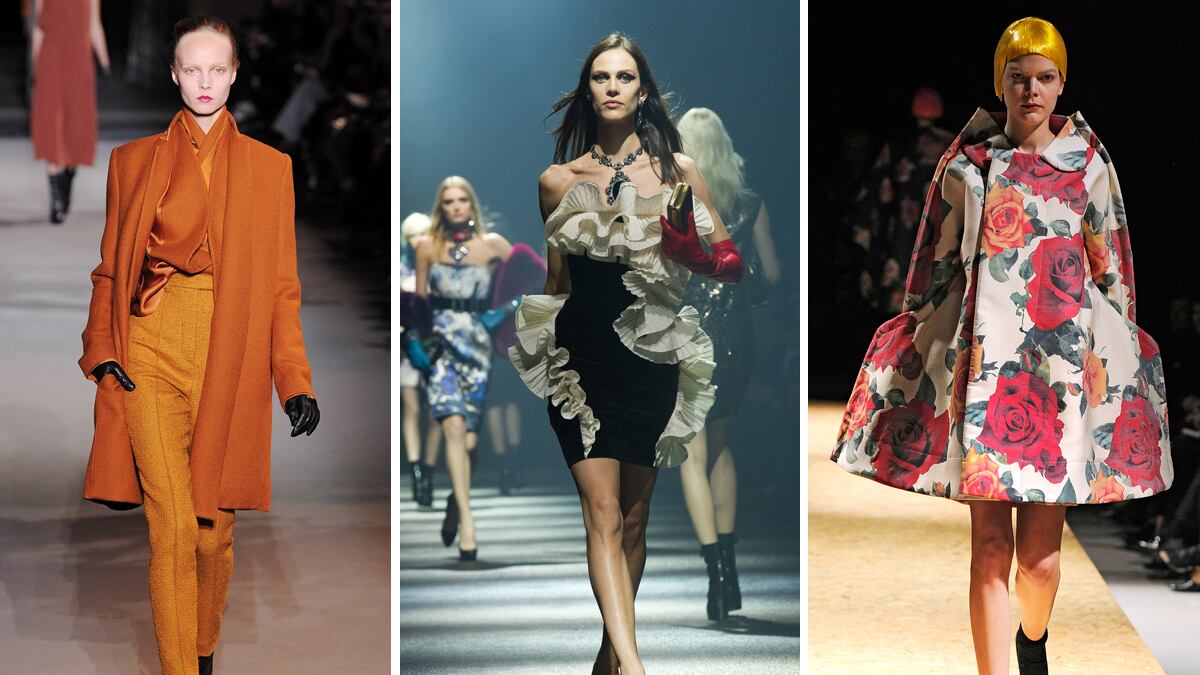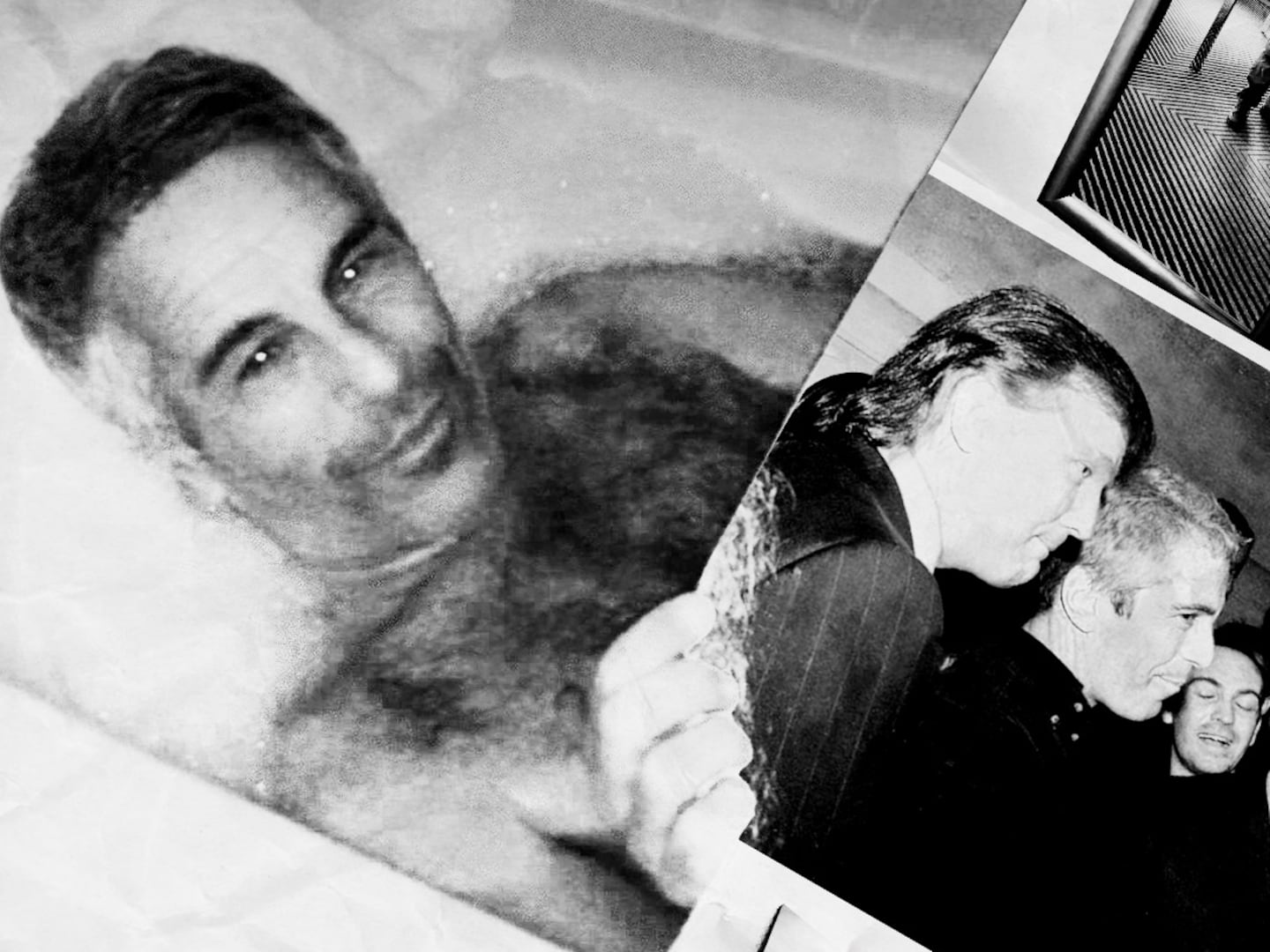
It’s difficult to understand why certain color combinations wallop the emotions with startling impact. It’s hard to explain why some fabrics and silhouettes make a woman feel as if her beauty is effortless. And ultimately, it may be impossible to figure out precisely why certain clothes can make a woman feel smart—as though she has deciphered a riddle that eludes most everyone else or avoided a trap into which others have stumbled.
As designers unveil their fall 2012 collections in Paris, three artful craftsmen each accomplished one—or more—of these bewildering feats. Haider Ackermann presented a glorious collection that was, he said, inspired by the colors of fall leaves. It was a showcase of painterly beauty in which shades of persimmon, burnt orange, lavender, and fiery red brushed against one another in ways that were both lush and simple.
Designer Alber Elbaz celebrated his 10th anniversary at Lanvin with an audacious collection, a heartfelt serenading of his audience, and a roof-rattling party. During his decade at Lanvin, Elbaz has developed a distinctive vocabulary that defines the intersection of confidence and grace, femininity, and power. He loves the sheen and sensuality of satin and the sculptural quality of sturdy wool. He embraces asymmetry, is besotted by rhinestones, and swoons over the promise of romance hidden in dark shadows. With vision and skill, he has transformed Lanvin from a dead label into a thriving business with double-digit revenue growth last year.
Women buy his clothes, said retailer Karen Daskas, co-owner of the boutique Tender in Birmingham, Mich., because his gently draped dresses, often adorned with jewels or grosgrain ribbon, make customers feel pretty. They might be amused by Lanvin’s celebrity clientele such as Tilda Swinton and Julianne Moore—and even first lady Michelle Obama—but they are not compelled by them. Lanvin’s customers—the lawyers, businesswomen, and philanthropists—care very little about the buzz attached to the brand and the fact that the amiable designer is always considered a contender when some larger, flashier fashion house goes headhunting. His customers are, quite simply, drawn to the clothes.
Given the myriad illogical insecurities that women can have about their bodies, Elbaz’s capacity for aesthetic reassurance and understanding is no modest feat.
At Comme des Garçons, designer Rei Kawakubo offered an intellectually playful collection of two-dimensional clothes—dresses that were flat as a pancake, jackets with sleeves that looked more like envelopes than like cylinders, and trousers that gave the models the physique of a chalk outline. And at Junya Watanabe, another brand under the Comme des Garçons umbrella, the designer played with the juxtaposition of typical menswear and womenswear fabrics, lining sweetly printed dresses with pinstripes and transforming khaki trenchcoats into capes. All of these tricks forced a furrowing of the brow, a quizzical expression, and the use of a little brain power to digest it all.
Indeed, Watanabe’s collection had the mind considering the circumstances surrounding the current vilification of bankers and Wall Streeters—namely the folks for whom a pinstripe suit is a uniform. By mocking the structure of jackets and turning them into capes, Watanabe, in essence, pinned the models’ arms to their side, taking away a bit of their freedom and power. He subtly dipped into the social currents that designers in New York studiously avoided.
These wholly different designers managed to create clothes that don’t merely speak to trends or satisfy a desire for status (although they all accomplish those things nicely). Instead, they attempt something far more ambitious. With their presentations, they use clothes to strike an emotional chord. They are not merely trying to stir up desire—to covet, to shop, to consume. They are striving to help women see some part of themselves on the runway.
Ackermann uses music, motion, and, of course, color to woo his audience. He presented his fall collection in the ornate grandeur of Paris’s Hôtel de Ville. With chandeliers overhead, his models walked at an unhurried pace to a soundtrack of bass drums and violins. His leather jackets and vests were constructed with peplums that swirled and blossomed just above the derriere. Thick knits in shades of copper swaddled the neck. Trim trousers in nubby shades of lilac were paired with jackets in iridescent hues of melon.
The collection was visual poetry with the colors colliding and blending as if seen through an ever-spinning kaleidoscope. But Ackermann’s collection was not all sweet dreams and emotions. There were real clothes here. Lush jackets were paired with skirts cut narrow and elegant. And he offered some of the most beautifully tailored high-waisted trousers of the season. If they fit the average woman as beautifully as they fit his models, Ackermann may singlehandedly renew the appeal of trousers after so many years when dresses have dominated the runway.
Elbaz was responsible for much of the industry’s shift toward dresses, and his 10th-anniversary collection was filled with them, many of which were adorned with flirtatious peplums or were slightly sculpted to emphasize a woman’s hourglass shape.
Elbaz juxtaposes the enduring appeal of black and its connotations of sex, power, and aggression with gentle ruffles framing a bared back, a brightly colored shrug, or a pair of bright-pink patent-leather heels.
This collection was not so much an indication of where the house is heading, but a celebration of where it is right now. Lanvin defines a style of gracious power dressing that makes a woman feel smart about her approach to style without removing any of fashion’s pleasure.
When the last model strode off the runway, a black curtain parted to reveal a party land lit with tiny twinkling lights with a bandstand—that called to mind a charming carousel—positioned center stage. Elbaz thanked his audience and then crooned a short version of “Que Sera, Sera” before inviting everyone to join him for champagne, dessert, and music.
Elbaz balances fashion’s serious side—the demands of big business and the responsibility that comes with being so instrumental in helping women craft a public image--with its playful nature. If a garment doesn’t bring you joy, after all, why spend thousands of dollars for it? A cheap T-shirt and jeans will suffice.
Kawakubo is not a designer who excels at communicating joy—at least not the emotive version of it. Even with this fall collection, with its shades of bright pink and childish floral prints, there remained an unwillingness to let go and luxuriate in pleasure. Indeed, her models marched the runway mostly without the benefit of music—only the sound of clunky heels clomping along a raised wooden platform. For Kawakubo, something always has to be held back. The unveiling of her collection in dreary silence was like a watching a child’s birthday party unfold without the cake.
The collection stirred images of women as paper dolls, as pressed and preserved flowers, as two-dimensional cartoons colored in with shades of pink. It was a quiet examination of traditional girlishness.
Ackermann proves that an exquisite palette can deliver pleasure as intoxicating as an illicit drug. Elbaz shows how graceful shapes both enhance and empower. But Kawakubo stands alone as a persistent rebel—and undeterred curmudgeon—reminding women to continue questioning the source and meaning of their delight.






